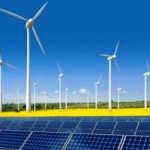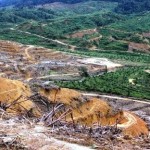First, present GHG emissions should be confirmed.
Domestic emissions in 2008 showed a 1.6 percent increase over the Kyoto Protocol baseline year of 1990. A 5.1 percent decrease has been settled through forest sinks and Kyoto credits already purchased by the government. In order to reach the Kyoto Protocol target of a six percent reduction compared to the baseline year, another 2.5 percent decrease is required. However, if Kyoto credits purchased independently by the industrial sector are considered (approximately 5.0% in 2008 and 4.1% in 2009 by power companies only *), the six percent reduction was roughly achieved for fiscal year 2008.
Domestic emissions in 2009 showed a 4.1 percent decrease compared to the baseline year, and another 5.3 percent decrease is settled through forest sinks and Kyoto credits already purchased by the government. In other words, for 2009, even without consideration of foreign credits obtained by the industrial sector, a 3.4 percent margin remains.
Meanwhile, the influence of the recent nuclear accident should be considered. According to Tokyo Electric Power Company, if the total power generated at Fukushima I nuclear power plant were to be replaced by fossil fuel power generation, an increase of 1.7 percent in greenhouse gas emissions would occur compared to 1990 nationwide totals. In other words, the 3.4 percent margin as of 2009 equals the increase in emissions that would arise from a switch from nuclear power to coal-fired power (1.7 x 2 = 3.4 percent, based on a two-year period from 2011-12).
These figures show that even if an economic recovery brought about an increase in emissions in 2010 and nuclear power plants do not operate, when foreign credits obtained by the industrial sector are considered and if the present level of energy conservation continues for a year or two, the situation does not immediately require a declaration of non-compliance with the Kyoto Protocol.
On the other hand, it is difficult at present to discuss the 25 percent reduction target for 2020 spearheaded by Former Prime Minister Hatoyama. Plainly stated, achievement of this target depends on,
- the kind of energy policy, society and lifestyles we will choose for ourselves and our children following the energy crisis we will face this coming summer, and
- whether government can actually succeed in creating policy and enduring institutions that reflects these choices, while breaking free from the bonds of vested interests.
Yet, to say the least, the international community will not accept easily an effortless expansion of coal-fired power plants. Once a coal-fired power plant is built, it will operate for 20 to 30 years. While awareness both in Japan and in the international society is lacking, one major reason for Japan’s increase in emissions after 1990 was the more than 30 percent increase in power generation capacity and power generation volume of coal-fired power plants.
Japan’s present situation is actually exactly the same as that of developing countries. Namely, developing countries in the past have mainly chosen inexpensive coal power with its strong vested interests in order to meet growing energy demand. Until now, Japan has criticized such choices. That same Japan, even after experiencing an earthquake disaster, will inevitably lose the trust of the international community if it advocates the exact opposite of what it has hitherto opposed. Criticisms can be expected, such as the fact that global warming increases the damages of typhoons and tsunami, and that Japan is attempting to export to the world the tsunami that caused so much damage at home. Another criticism could revolve around the fact that major disasters are nothing out of the ordinary in developing countries.
Expansion of coal-fired power is also economically unfavourable at this stage. The reason being that at present, the cost of power generation by renewable energies is dropping rapidly due to technological development and market expansion. Meanwhile, a steep rise in fossil fuel costs is forecast. Considering the possibility that carbon dioxide emissions reduction measures must be devised in the future, such as carbon capture and storage (CCS), the cost advantage for renewable energies could potentially reach the same level as coal, or exceed it. (Moreover, Japan possesses no suitable places to store the massive volume of carbon dioxide collected.) Further, European and North American nations, as well as emerging nations, are substantially expanding investment and technological development in renewable energies and energy conservation, reputed to be the only growing industries of the 21st century. An even greater gap will arise between other countries and the Japanese industries that already have fallen behind.
3. Issuance of Low-Carbon Recovery Bonds
In order to restore the damaged areas in Eastern Japan and stabilize energy supply, investment of funds on a national, corporate and individual level will be required on a scale of several trillion to several ten trillion JPY. The problem is who will raise such funds and how and for what they will be used. Two proposals follow.
First, a reorganization of the energy-related budget that is excessively biased toward nuclear power is required. Until now, over 90 percent of the government’s general account energy expenditures (approximately JPY 100 billion) and over 70 percent of the energy-related special account budget (approximately JPY 400 billion) was put toward nuclear power.
Second, “low-carbon recovery bonds” should be issued aimed specifically at investment in renewable energies and energy conservation. Already, “construction bonds” exist in Japan for improvements in social infrastructure. Under the centralized management of a “Rehabilitation and Recovery Agency” that rejects the vertical divisions of government offices, and moreover, with limits set on uses, the impact of these bonds of a scale of several trillion JPY on interest rates and inflation would likely be small.
As for redemption, methods that do not give the impression of forsaking fiscal discipline can be devised. For example, tax revenue based on the establishment of a temporary consumption tax aimed at recovery and additional levying of income tax and corporate tax could be applied.
An important point regarding these “low-carbon recovery bonds” is that they will ultimately pay for themselves. According to calculations of the Central Council for Environment’s Committee on the Mid-term Roadmap, in order to realize a 25 percent GHG emission reduction (compared to 1990) by 2020 and achieve a low-carbon society, an additional investment of approximately JPY 10 trillion annually is required. However, approximately half of the total amount invested up to 2020 in global warming measures (the majority of which are essentially adoption of renewable energies and energy conservation) and an amount nearly equaling the entire amount invested by 2030, can be recovered due to savings on fossil fuel costs.












